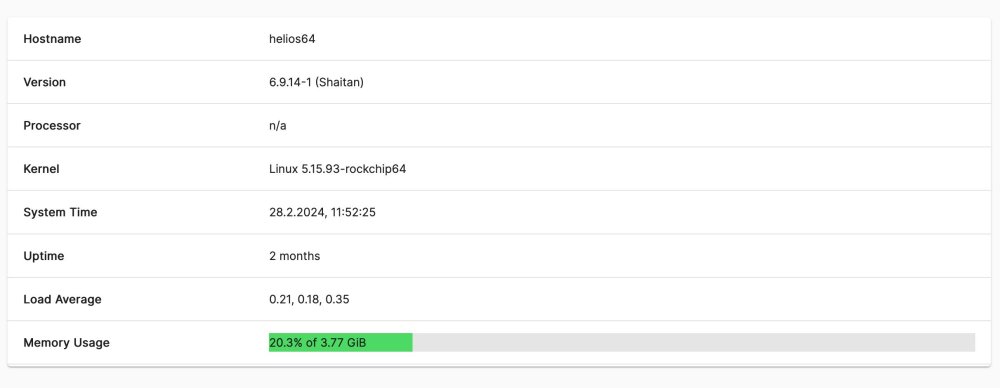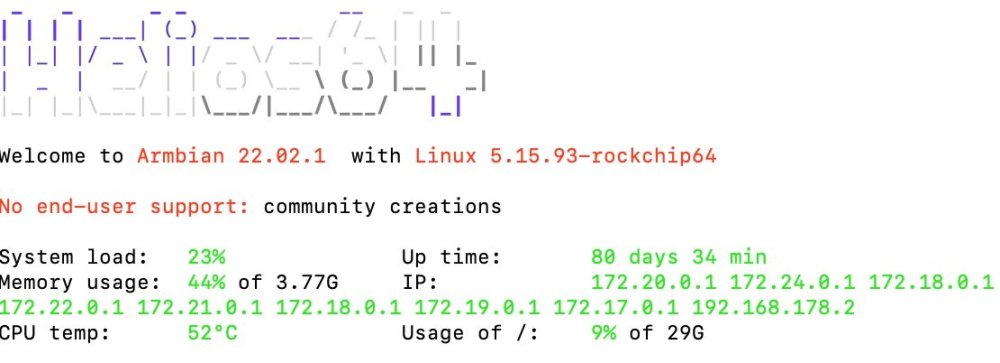
bunducafe
Members-
Posts
64 -
Joined
-
Last visited
Recent Profile Visitors
The recent visitors block is disabled and is not being shown to other users.
-
And sold, that was a quick one 😉
-
Hi folks, I upgraded my server towards a bigger machine and unfortunately neither my parents nor brothers need a reliable fileserver. So this little machine goes on sale. - Helios64 with all trays + 2 SSD inserts - Fully assembled - Original packaging - Changed the two fans for Noctuas in order to get an even more silent server What's missing is the Battery for UPS. Mine was faulty and caused me some random reboots. Condition is mint / very good. System is stable with 5.15.93 running OMV6. If you would like pictures of the machine itself please drop me a note.
-

Anyone here have a stable Helios64 running OMV6?
bunducafe replied to TijuanaKez's topic in Rockchip
I am also quite happy. Would you kindly tell us on what kernel you are currently on? -
What are you running the helios64 with? OMV? Did you do any manual changes within the system? I once had a faulty battery. Once I ripped that out everthing worked again... What does the log tell you once the machine goes down? I can feel the frustration but I believe if configured correctly the machine might run reasonably.
-
Which kernel are you on? I am running my machine now for over 80 days without any issues whatsoever. See screenshot. I started from the last official image and then updated manually to the 5.15.93 kernel. Then rebooted and froze further kernel updates. Then I updated all the rest. Since then I have a solid machine and I won't go any further kernelwise.
-

Helios64 unstable with 23.8.1 Bullseye and 6.1.50-current-rockchip64
bunducafe replied to TDCroPower's topic in Rockchip
I usually do an update only via OMV. But no matter which way you use once the kernel is frozen it should only update the packages accordingly until that version. At least that's what it is in my case. In the past I just put in the terminal commands you mentioned. I believe the update process via armbian-config is identical (someone correct me pls if I am wrong) - and so is the OMV command, too. -

Helios64 unstable with 23.8.1 Bullseye and 6.1.50-current-rockchip64
bunducafe replied to TDCroPower's topic in Rockchip
@TDCroPower as stated above. I use the old image and manually update the kernel until 5.15.93 and then freeze the kernel. Some reboots might be required anyway. Once it is up and running again I would then perform apt update && apt upgrade. Because of the frozen kernel the firmware should not update to any higher version same es the packages a higher kernel would require. -

Helios64 unstable with 23.8.1 Bullseye and 6.1.50-current-rockchip64
bunducafe replied to TDCroPower's topic in Rockchip
That's kind of strange. I freeze the kernel via armbian-config as mentioned in previous posts and it holds it on my machine. Of course you can use the CLI as well. Then it should work with the apt-mark command. Are you running OMV on top of Armbian? Or are you using a different nas software? -

Helios64 unstable with 23.8.1 Bullseye and 6.1.50-current-rockchip64
bunducafe replied to TDCroPower's topic in Rockchip
Could you try get the 5.10.63 image on sd-card and then go to kernel 5.15.93 via armbian-config and then apply apt update / apt upgrade? I somehow think that with updating to the latest kernel and then switch back to an older kernel the system already got corrupted. -

Helios64 unstable with 23.8.1 Bullseye and 6.1.50-current-rockchip64
bunducafe replied to TDCroPower's topic in Rockchip
I usually run the machine between 400 and 1400 MHz ondemand governor. Yesterday it was set to full speed while performing a SnapRaid scrub... you may have to figure out what's best for your setup, but the mentioned range was the one I ran the helios64 for over 2 months without any issue whatsoever. -

Helios64 unstable with 23.8.1 Bullseye and 6.1.50-current-rockchip64
bunducafe replied to TDCroPower's topic in Rockchip
Freezing the kernel is easy within armbian-config. Just go to System / Security and hit Disable Kernel updates (Freeze) Yes, I often started with a blank 5.10.63 system and then performed the updates to 5.15.93 accordingly. You can also set the kernel via armbian-config first, then let the machine do it's job and afterwards you freeze the kernel and do all the updates. Meanwhile I have a bunch of "old" images here of working SD-cards that I can always revert back to. That saved my ass also in the latest update trouble. For me 5.10.63 was not entirely stable but 5.15.93 is rock solid. So I would give it a go. Also: I will probably never update the kernel anytime soon and stick to my running system. I might compile it one day with a newer kernel but this is a bit farer away as I had no success with my first attempts and do not have the time to dig deeper into that. -

Helios64 unstable with 23.8.1 Bullseye and 6.1.50-current-rockchip64
bunducafe replied to TDCroPower's topic in Rockchip
Just a quick one: Accidentally updated the machine three days ago and it got stuck in a boot loop. I forgot to freeze the kernel to 5.15.93 and that's what caused the issue. I reverted back to the old kernel, froze the kernel and then did the update via OMV and everything works as expected. I know, not a real solution to the problems (I did not hook the laptop in order to get the console working) but a workaround for those who have a running backup (here with SD cards) -

Anyone here have a stable Helios64 running OMV6?
bunducafe replied to TijuanaKez's topic in Rockchip
Nope. I just left everything as it is... -

Anyone here have a stable Helios64 running OMV6?
bunducafe replied to TijuanaKez's topic in Rockchip
But it does reboot every 10 days by itself? Here I don't have any difficulties with the said settings. So maybe there is a different setting / hardware issue that causes the reboots. Mine has now been stable one month (touch wood). I will definitely use the machine as long as it runs... Harddisks: - SSD with media library and stores all docker containers - 4x 4TB HDDs (3 are merged with mergerfs and 1 hdd is solely the parity disk for snapraid) Not too many fancy things further on. Docker runs Jellyfin and Navidrome. VPN and mediastacks are only running when needed to. Otherwise I stop these containers. -

Anyone here have a stable Helios64 running OMV6?
bunducafe replied to TijuanaKez's topic in Rockchip
@mrjpaxton Well, at least once you set up the helios64 with the oldest official kernel you can indeed upgrade to Debian Bullseye (11) which gives you still a bit of time as long time support will be approx. until 2026. I am a bit at easy with the machine as it runs flawlessly. If I won't be able to build my own kernel until then I might just leave it as it is. Exposed only to the local network I don't see too much of a security risk either... but let's see how everything turns out. Maybe I will shift to a different NAS enclosure that "just runs" and has a decent support. On the other side I quite liked Kobol's approach with the Helios64.



